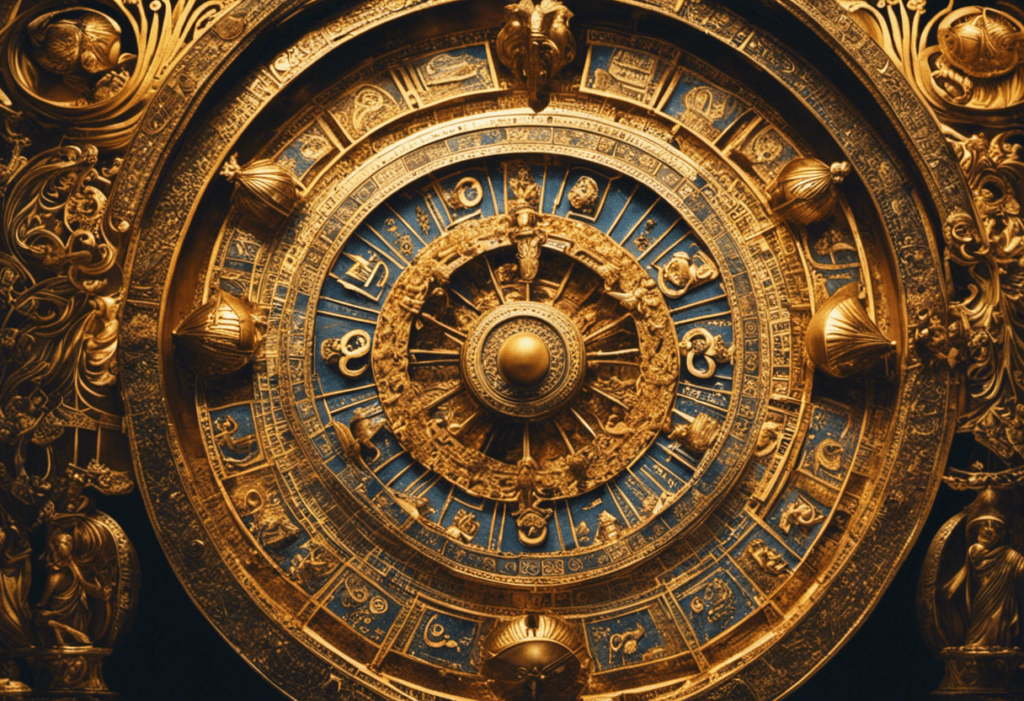Step into the vibrant world of Zoroastrianism, where time is adorned with a tapestry of festivals and celebrations. From the jubilant Nawruz, welcoming the Zoroastrian New Year, to the solemn Muktad, honoring the ancestors, each occasion holds a profound significance within this ancient tradition.
This article delves into the rich tapestry of Zoroastrian festivals, exploring their cultural, spiritual, and historical importance. Join us on this enlightening journey, as we unravel the essence of time through the lens of Zoroastrianism.
Key Takeaways
- Nawruz is a time of renewal and rebirth celebrated by Zoroastrians worldwide, featuring the Haft-Seen table and spring cleaning as traditional customs.
- The Yasna ceremony is a means to honor Zoroaster, involving sacred rituals, prayers, and offerings performed by trained priests known as mobeds.
- Muktad is a festival where Zoroastrians remember their ancestors and honor them with prayers and rituals, fostering unity and maintaining a spiritual connection with one’s roots.
- Gahanbar festivals, Sadeh, and Mihragan are seasonal celebrations that involve prayers, rituals, and communal feasting, symbolizing spiritual purification, renewal, and gratitude for nature’s abundance.
Celebrating Nawruz: The Zoroastrian New Year
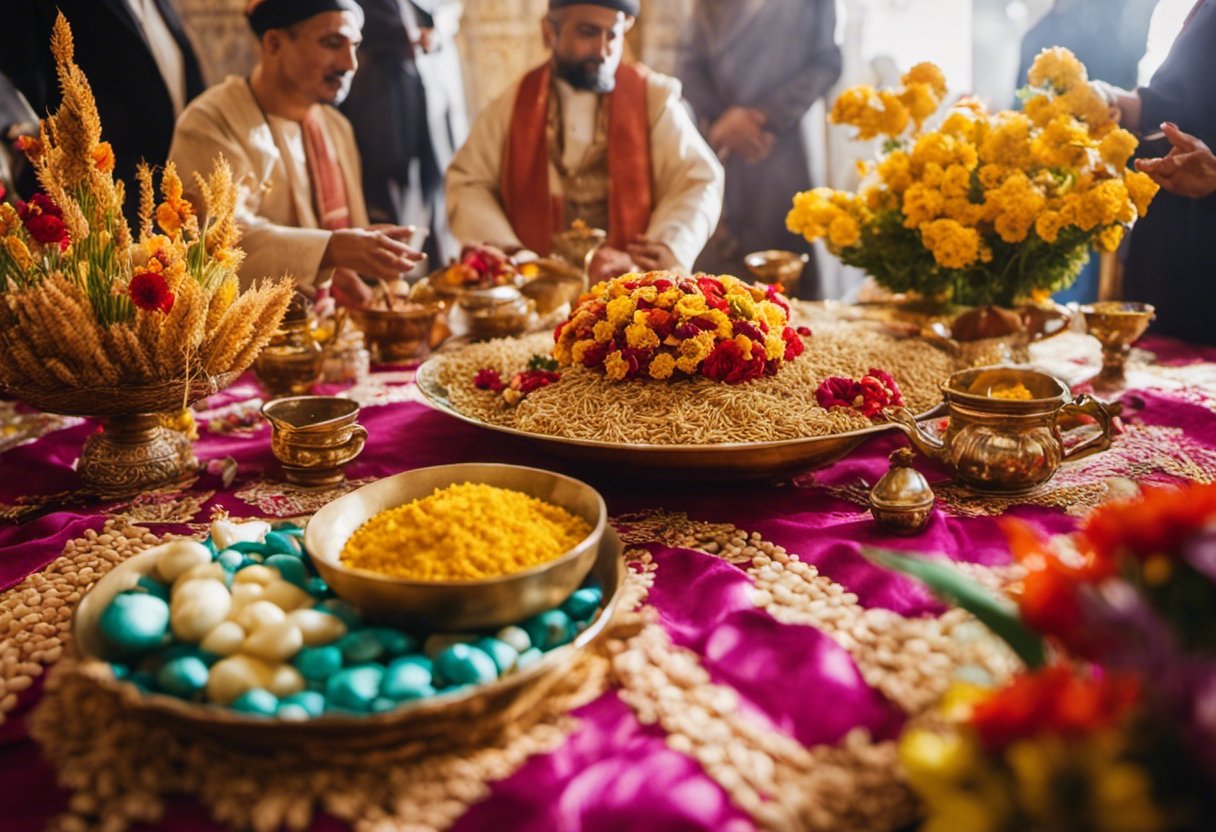

The article explores the significance and customs surrounding the celebration of Nawruz, the Zoroastrian New Year. Nawruz, which means ‘new day,’ is celebrated by Zoroastrians worldwide as a time of renewal and rebirth. This ancient festival holds great importance in the Zoroastrian tradition and is marked by various traditional customs.
One of the key customs during Nawruz is the setting up of a Haft-Seen table. This table is adorned with seven symbolic items, each beginning with the Persian letter ‘seen,’ representing different aspects of life and nature. These items can include sprouts, symbolizing rebirth; apples, symbolizing beauty and health; and a mirror, symbolizing reflection and self-awareness. The Haft-Seen table serves as a focal point for family and friends to gather and celebrate the arrival of the new year.
Another traditional custom during Nawruz is the practice of spring cleaning. Zoroastrians believe that this ritual purifies the home and prepares it for the new year. It is customary to thoroughly clean the house, getting rid of any clutter or negative energy. This act of cleaning symbolizes the removal of impurities and the welcoming of fresh beginnings.
Overall, celebrating Nawruz is a cherished tradition for Zoroastrians, filled with customs that reflect the values of renewal, purification, and hope for a prosperous year ahead.
Honoring Zoroaster: The Yasna Ceremony
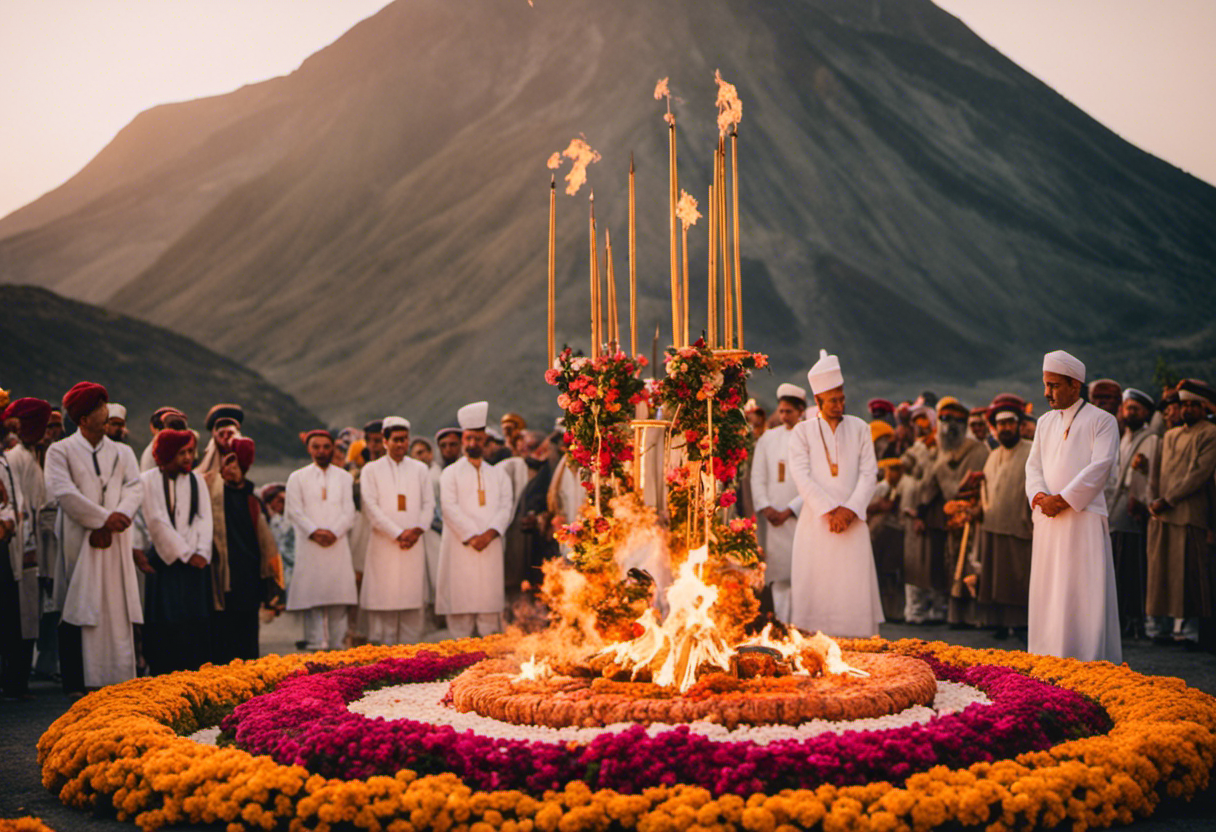

The Yasna ceremony holds a significant place in the Zoroastrian tradition, serving as a means to honor and pay homage to the prophet Zoroaster. This sacred ritual involves intricate prayers and offerings, symbolizing the spiritual connection between the Zoroastrian community and their revered figure.
Through the Yasna ceremony, Zoroastrians actively engage in their faith, reaffirming their devotion and seeking spiritual guidance from Zoroaster.
Sacred Rituals and Prayers
Sacred rituals and prayers play a pivotal role in the Yasna ceremony, an integral part of honoring Zoroaster in the Zoroastrian tradition.
The Zoroastrian religion places great emphasis on spiritual practices and religious ceremonies as a means of connecting with the divine.
The Yasna ceremony, specifically, is a sacred ritual that involves recitation of hymns and prayers, accompanied by the offering of sacred substances such as milk, water, and incense.
These rituals are performed by priests known as mobeds, who are highly trained in the intricacies of the ceremony.
Through the performance of these rituals and the recitation of prayers, Zoroastrians seek to establish a direct connection with Ahura Mazda, the supreme deity in their religious belief system.
The Yasna ceremony is not only a religious observance but also a time for communal gathering and celebration, fostering a sense of unity and devotion among the Zoroastrian community.
Symbolic Significance of Yasna
Yasna, with its intricate rituals and prayers, holds immense symbolic significance in the Zoroastrian tradition, serving as a means of spiritual connection and devotion to Zoroaster. This ancient tradition encompasses a variety of symbolic rituals that are deeply ingrained in the Zoroastrian community. These rituals serve several purposes, including:
-
Uniting the community: Yasna brings together members of the Zoroastrian community, fostering a sense of unity and shared identity.
-
Renewing spiritual energy: Through its rituals, Yasna allows individuals to renew their spiritual energy and reaffirm their commitment to the Zoroastrian faith.
-
Connecting with divine beings: The prayers and rituals performed during Yasna serve as a means of connecting with the divine beings of the Zoroastrian pantheon.
-
Preserving cultural heritage: Yasna plays a crucial role in preserving the ancient traditions and cultural heritage of the Zoroastrian community, ensuring their continuity for future generations.
Overall, Yasna serves as a powerful symbol of the Zoroastrian faith, allowing individuals to engage in meaningful spiritual practices and connect with their ancient traditions.
Zoroastrian Community’s Spiritual Connection
As individuals engage in the Yasna ceremony, their spiritual connection with the Zoroastrian community deepens, reinforcing their devotion to the teachings of Zoroaster. The Yasna ceremony is one of the most important spiritual practices in the Zoroastrian tradition, involving prayers, offerings, and rituals to honor Ahura Mazda, the supreme deity.
This ceremony is typically performed in community gatherings, where believers come together to strengthen their bonds and share in a collective experience of worship. These gatherings not only serve as spaces for spiritual reflection and growth, but also foster a sense of belonging and solidarity within the Zoroastrian community.
Through their active participation in the Yasna ceremony and other communal practices, individuals are able to cultivate a deeper understanding of their faith, and find strength and inspiration in the shared experiences of their fellow believers.
Commemorating Muktad: Remembering the Ancestors


During Muktad, Zoroastrians remember their ancestors and honor them with prayers and rituals. This festival holds great significance in the Zoroastrian tradition as it serves as a time for the community to reflect on their ancestral heritage and pay tribute to those who came before them. The practice of remembering ancestors and engaging in ancestral worship is deeply rooted in Zoroastrianism and is considered an essential part of maintaining a spiritual connection with one’s roots.
-
Prayers for the departed: Zoroastrians believe in the eternal presence of the soul, and during Muktad, special prayers are offered for the departed souls of ancestors. This act is seen as a way to provide spiritual support and assistance to those who have passed away.
-
Rituals and ceremonies: Muktad is marked by various rituals and ceremonies that are performed to honor the ancestors. This may include lighting candles, offering flowers and fruits, and reciting sacred texts. These rituals serve as a means of expressing gratitude and seeking blessings from the ancestral spirits.
-
Community gatherings: Muktad brings the Zoroastrian community together, fostering a sense of unity and shared purpose. Community members gather in prayer halls and fire temples to participate in the rituals and ceremonies, strengthening their bonds and collective identity.
-
Legacy and continuity: By remembering their ancestors, Zoroastrians acknowledge the importance of their legacy and the contributions they have made to the community. This practice creates a sense of continuity and encourages future generations to carry forward the values and traditions of their ancestors.
Observing Gahanbar: The Seasonal Festivals


Zoroastrians actively participate in the observance of Gahanbar, marking the seasonal festivals with a deep sense of reverence and devotion. Gahanbar celebrations are an integral part of the Zoroastrian tradition and play a significant role in the religious and cultural life of the community. These seasonal rituals are observed six times a year, corresponding to the six seasons of the ancient Iranian calendar.
The Gahanbar festivals are celebrated in honor of the six Amesha Spentas, or the divine entities that represent various aspects of creation and existence. Each Gahanbar festival is dedicated to one of these Amesha Spentas, with each festival falling at the end of a particular season. The purpose of these celebrations is not only to mark the changing of seasons but also to express gratitude and seek blessings for the well-being of the community and the world.
During Gahanbar, Zoroastrians engage in a variety of religious activities, including prayers, rituals, and communal feasting. These festivals bring the community together and foster a sense of unity and solidarity among its members. The rituals performed during Gahanbar are believed to bring about spiritual purification, renewal, and rejuvenation.
The importance of Gahanbar celebrations in the Zoroastrian tradition cannot be overstated. These seasonal festivals serve as a reminder of the cyclical nature of life and the interconnectedness of all beings. They provide an opportunity for reflection, gratitude, and renewal, reinforcing the spiritual and cultural identity of the Zoroastrian community.
Participating in Sadeh: The Festival of Fire
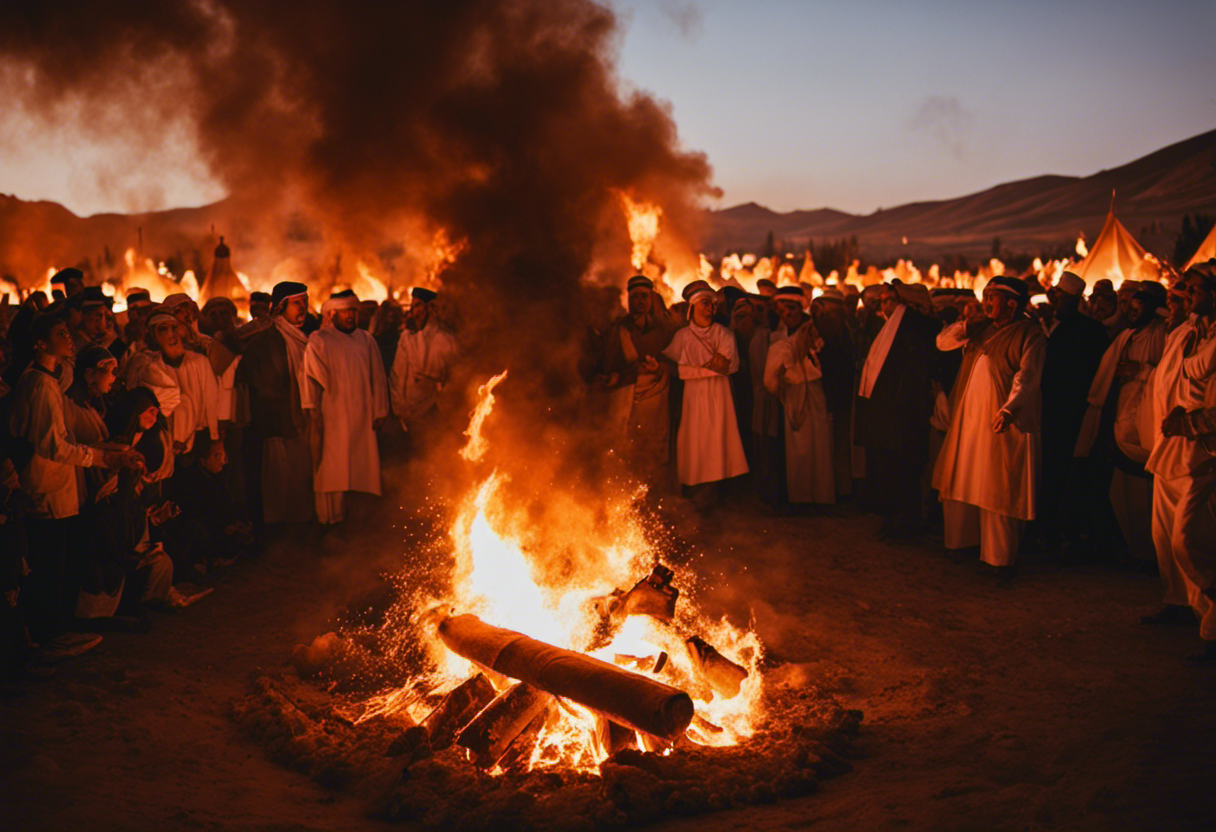

The festival of fire, Sadeh, allows individuals to actively engage in communal rituals and ignite bonfires as a symbol of purification and renewal. Participating in Sadeh: The Festival of Fire holds deep cultural significance in the Zoroastrian tradition. Here are four key aspects of the celebration:
-
Ancient Origins: Sadeh is an ancient festival that predates Zoroastrianism itself. It is believed to have originated in prehistoric times, symbolizing the triumph of light over darkness and the arrival of longer days.
-
Purification and Renewal: The lighting of bonfires is a central feature of Sadeh. The flames are seen as a means of purifying the world, warding off evil spirits, and bringing forth positive energy and renewal.
-
Community Bonding: Sadeh is a communal celebration that brings people together. It fosters a sense of unity and strengthens social ties as individuals gather around the bonfires, share food, and engage in prayers and festivities.
-
Cultural Preservation: Participating in Sadeh helps preserve and pass on the rich Zoroastrian cultural heritage from one generation to another. It serves as a reminder of the ancient traditions and values that continue to shape the beliefs and practices of Zoroastrians today.
Embracing Mihragan: The Festival of Mithra
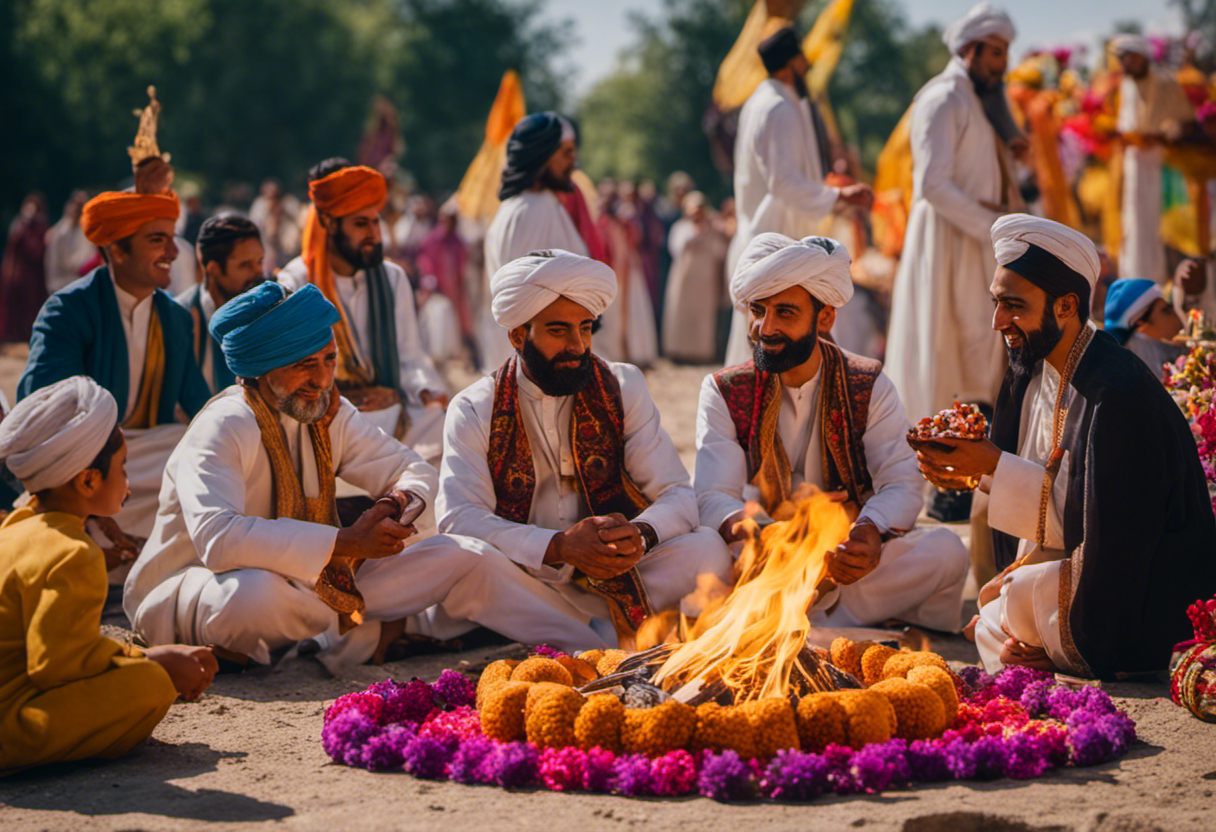

As Mihragan, the Festival of Mithra, approaches, individuals have the opportunity to immerse themselves in the vibrant traditions and rituals that celebrate the divine qualities of Mithra. This ancient Zoroastrian festival holds great significance within the religious and cultural framework of the Zoroastrian community. The rituals and traditions associated with Mihragan are deeply rooted in the historical origins of the religion.
Mihragan, also known as Mehregan, is a festival dedicated to the worship of Mithra, the Persian god of light, truth, and justice. It is believed to have originated in ancient Persia and has been celebrated for thousands of years. The festival marks the arrival of autumn and is a time of thanksgiving for the harvest and the abundance of nature. It is a time when people come together to honor Mithra and seek his blessings for prosperity and happiness.
The rituals and traditions of Mihragan vary among different Zoroastrian communities, but they all share a common purpose of honoring Mithra. These rituals often include prayers, offerings, feasts, and social gatherings. People decorate their homes with flowers and colorful fabrics, symbolizing the beauty and joy of the festival. They also exchange gifts and visit relatives and friends, fostering a sense of community and togetherness.
The historical origins of Mihragan can be traced back to the ancient Persian empire, where the worship of Mithra was widespread. Mithra was considered a powerful deity, associated with the sun and the forces of light. The festival of Mihragan was an important event in the religious calendar of ancient Persia, and its significance has transcended time and geography.
Conclusion
In the rich Zoroastrian tradition, festivals and celebrations play a vital role in marking significant moments in time. From the joyous Nawruz, the Zoroastrian New Year, to the solemn Muktad, a time of remembrance for ancestors, each festival carries deep cultural and religious significance.
The observance of Gahanbar, the seasonal festivals, and the participation in Sadeh, the Festival of Fire, further emphasize the connection between the Zoroastrians and nature.
Finally, the embrace of Mihragan, the Festival of Mithra, highlights the importance of unity and harmony within the community. Through these diverse celebrations, Zoroastrians continue to honor their ancient traditions and strengthen their spiritual bonds.



